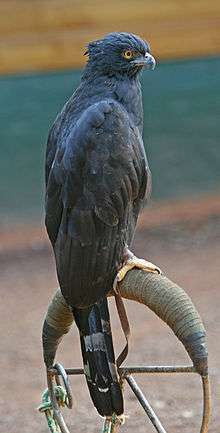Black hawk-eagle
The black hawk-eagle (Spizaetus tyrannus), also known as the tyrant hawk-eagle,[2] is a species of eagle found from central Mexico through Central America[3] into Colombia, eastern Peru, the south of Brazil, and as far as northern Argentina.[4] There are two known subspecies, S.t. tyrannus, which is found in Southeastern Brazil and Northeastern Argentina, and the slightly smaller S. t. serus, which can be found elsewhere throughout the species' range.[5] Its preferred habitats include humid and moist forests close to rivers, and several types of woodland.[6] It is uncommon to fairly common throughout most of its range. Its closest relative is the ornate hawk-eagle, which is similar in size, appearance and behavior but lives at lower elevations.
| Black hawk-eagle | |
|---|---|
.jpg) | |
| Scientific classification | |
| Kingdom: | Animalia |
| Phylum: | Chordata |
| Class: | Aves |
| Order: | Accipitriformes |
| Family: | Accipitridae |
| Genus: | Spizaetus |
| Species: | S. tyrannus |
| Binomial name | |
| Spizaetus tyrannus (Wied, 1820) | |
Description


The black hawk-eagle is 58–70 cm (23–28 in) long and weighs about 900–1,300 grams (2-2.9 lbs). It has black plumage with varying patterns on its wings and body, and white speckling in places. It has barred wings, slightly elliptical in shape, and a long, narrow tail which is rarely fanned. The four grey bars on the tail are distinctive to the black hawk-eagle, as is the white line seen slightly above the bird's eye. While flying, the broadness and shortness of the wings become apparent.[7] While in flight, the bird's tail is typically kept closed.[4][6]
Diet
Though light and small compared to other eagles, this bird is a powerful predator that frequently hunts relatively large prey. It mainly eats large rodents, opossums and monkeys, as well as, occasionally, bats, birds and some reptiles.[3][8] Its popular name in Brazil is "Gavião-pega-macaco", which means "monkey-catching hawk". The birds it takes can be quite large, such as toucans, and chachalacas.[6]
Breeding
.jpg)
The black hawk-eagle's breeding behaviour is little known. In a study carried out in Guatemala by The Peregrine Fund, four nests were documented. The average nest height was 25.5m and the nests were all built in lateral limbs away from the center of the tree. All known breeding pairs, both in the wild and in captivity, have laid single egg clutches and the estimating incubation period is 44 days.[5]
Notes
- BirdLife International (2012). "Spizaetus tyrannus". IUCN Red List of Threatened Species. 2012. Retrieved 26 November 2013.CS1 maint: ref=harv (link)
- Tyrant Hawk-eagle Retrieved on 14 August 2007
- "Black Hawk-Eagles in Panama | Whitehawk Birding Blog". 2020-05-07. Retrieved 2020-06-28.
- "Black Hawk-Eagle – Spizaetus tyrannus". Retrieved 14 August 2007.
- Whitacre, David F. "Neotropical Birds of Prey- Black Hawk-eagle". p. 185-202.
- "Black Hawk-Eagle". Retrieved 14 August 2007.
- Birds of Venezuela by Steve Hilty. Princeton University Press, 2003
- "Spizaetus tyrannus". www.globalraptors.org. Retrieved 2020-06-28.
